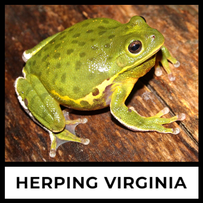Species Information
Recognized Subspecies in VA: None
Size: 2 - 4.5 inches Range): Abundant in the mountains and northern Piedmont, yet absent from the southern Piedmont and southern Coastal Plain Status: Least Concern
Recent DNA studies show Northern Dusky is actually a species complex of several potential new species. These species have not been named yet, but they do have monikers given to them based off of the study. For more, see the below.
Duskies can be a hard genus of salamanders to learn, but the first step is to learn the Northern Dusky. This is the most common, and wide spread Dusky in Virginia, and if one can rule out this species, it can be a lot easier to identify the individual. This species can be found in muddy or rocky streams, usually without a lot of current, by flipping rocks and logs. I have found a few by road cruising along creeks on really wet nights. Nets are often required to catch these, as they often dart into the creek upon being flipped.
Northern Duskies are usually brown, often with a dorsal stripe that is a different shade of brown, red, purple, orange, or even yellow. Their undersides are typically marbled, but can be plain. This species usually has a yellow, orange, or white eye-jaw stripe, but sometime this is faint and hard to see. This species has a flat, keeled tail, but not quite paddle-like or as keeled as say a Black-bellied Salamander. The tail often has a stripe brighter than the dorsal stripe. Similar Species: This species is similar to most Dusky species in the state. There are too many to go through great detail here, but all of these species will have more discriminatory information on their own pages, but I will attempt a “lightning round” approach below. Flathead Salamander: Only found in a small area in the southwestern Piedmont; the two exclude one another; blotchier pattern on dorsal Holbrook's Southern Dusky: Only found in southern Coastal Plain; granite pattern Black Mountain Salamander: Only found on the Cumberland Plateau; brown overall; juveniles have red-orange dorsal spots; adults are duller and more of a yellow-brown in most cases. Seal Salamander: Small, random dark "leopard" spots; juveniles have alternating yellow blotches on the tail Shovelnose Salamander: Very rare and limited range near Mount Rogers; cat-eyes; paddle-like tail; golden flecks in dorsal pattern Kanawha Blackbelly Salamander: Only found in the southern Blue Ridge; wider head, with frog-like face; dark belly; more keeled tail; camo-orange dorsal "Mountain Dusky" Complex: Cylindrical tail (in most cases); dark belly with blue-white flecks; adults are a solid chocolate brown; narrower body. Maps and External Sources
Comments are closed.
|
Species ProfilesThis page contains species information and links to external sites. Categories
All
|
|
Herping Virginia encourages all naturalists to practice ethical, safe, and sustainable herping. The use of proper herping methods and techniques is beneficial to both wildlife and herpers. Visit the links below for more information.
|
Copyright © 2024 Herping Virginia
